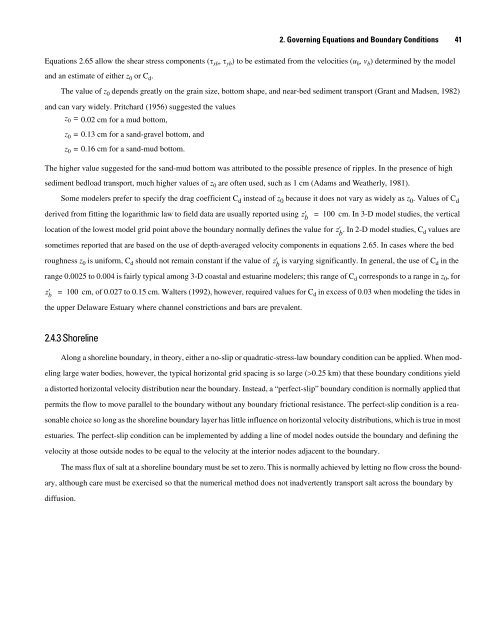A Semi-Implicit, Three-Dimensional Model for Estuarine ... - USGS
A Semi-Implicit, Three-Dimensional Model for Estuarine ... - USGS
A Semi-Implicit, Three-Dimensional Model for Estuarine ... - USGS
You also want an ePaper? Increase the reach of your titles
YUMPU automatically turns print PDFs into web optimized ePapers that Google loves.
2. Governing Equations and Boundary Conditions 41<br />
Equations 2.65 allow the shear stress components (τ xb, τ yb) to be estimated from the velocities (u b, v b) determined by the model<br />
and an estimate of either z 0 or C d.<br />
The value of z 0 depends greatly on the grain size, bottom shape, and near-bed sediment transport (Grant and Madsen, 1982)<br />
and can vary widely. Pritchard (1956) suggested the values<br />
z 0 = 0.02 cm <strong>for</strong> a mud bottom,<br />
z 0 = 0.13 cm <strong>for</strong> a sand-gravel bottom, and<br />
z 0 = 0.16 cm <strong>for</strong> a sand-mud bottom.<br />
The higher value suggested <strong>for</strong> the sand-mud bottom was attributed to the possible presence of ripples. In the presence of high<br />
sediment bedload transport, much higher values of z 0 are often used, such as 1 cm (Adams and Weatherly, 1981).<br />
Some modelers prefer to specify the drag coefficient C d instead of z 0 because it does not vary as widely as z 0 . Values of C d<br />
derived from fitting the logarithmic law to field data are usually reported using z' b<br />
= 100 cm. In 3-D model studies, the vertical<br />
location of the lowest model grid point above the boundary normally defines the value <strong>for</strong> z' b . In 2-D model studies, C d values are<br />
sometimes reported that are based on the use of depth-averaged velocity components in equations 2.65. In cases where the bed<br />
roughness z 0 is uni<strong>for</strong>m, C d should not remain constant if the value of z' b is varying significantly. In general, the use of C d in the<br />
range 0.0025 to 0.004 is fairly typical among 3-D coastal and estuarine modelers; this range of C d corresponds to a range in z 0, <strong>for</strong><br />
z' b<br />
= 100 cm, of 0.027 to 0.15 cm. Walters (1992), however, required values <strong>for</strong> Cd in excess of 0.03 when modeling the tides in<br />
the upper Delaware Estuary where channel constrictions and bars are prevalent.<br />
2.4.3 Shoreline<br />
Along a shoreline boundary, in theory, either a no-slip or quadratic-stress-law boundary condition can be applied. When mod-<br />
eling large water bodies, however, the typical horizontal grid spacing is so large (>0.25 km) that these boundary conditions yield<br />
a distorted horizontal velocity distribution near the boundary. Instead, a “perfect-slip” boundary condition is normally applied that<br />
permits the flow to move parallel to the boundary without any boundary frictional resistance. The perfect-slip condition is a rea-<br />
sonable choice so long as the shoreline boundary layer has little influence on horizontal velocity distributions, which is true in most<br />
estuaries. The perfect-slip condition can be implemented by adding a line of model nodes outside the boundary and defining the<br />
velocity at those outside nodes to be equal to the velocity at the interior nodes adjacent to the boundary.<br />
The mass flux of salt at a shoreline boundary must be set to zero. This is normally achieved by letting no flow cross the bound-<br />
ary, although care must be exercised so that the numerical method does not inadvertently transport salt across the boundary by<br />
diffusion.

















